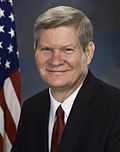Background
In 2002, Tim Johnson was re-elected by a narrow margin of 527 votes, the closest senate contest in the country that cycle. [2] Two years later, Republicans flipped the state's other senate seat, ousting then Senate Minority Leader Tom Daschle. [3] Heading into 2008, the seat was poised to be a heavily contested one, and Republicans saw as a strong potential flip. [4]
But the race would be upended on December 13, 2006, when Senator Johnson was hospitalized with what was later revealed to be a brain hemorrhage. [5] [6] This immediately shook up the state of the race, and dashed much of the discourse surrounding it for a time. [7] On the Democratic side, there was uncertainty if Johnson would be able to return to the Senate, and speculation surrounded whether Stephanie Herseth-Sandlin, the state's at-large Congresswoman, would run in his place. [8] [9]
However, by all accounts, Johnson still intended to run for re-election as long as his health kept improving, and prominent Democrats such as Harry Reid and Ted Kennedy held fundraisers for Johnson. [9] After a 9-month absence, Johnson returned to the Senate in August 2007, and was back to his duties as Senator in September 2007. [10] One month later, Johnson ended all speculation, by announcing his bid for re-election. [11]
General election
Campaign
Already a well-regarded figure, following health problems, Johnson became more popular. "South Dakota is a very kind state," Steve Jarding, a Harvard political scientist who ran Johnson's campaign, said. "People were rooting for Tim—Democrats, Republicans, independents—they wanted him to be O.K. [4] " He was also seen a pragmatic moderate. He received endorsements from the Republican Mayor of Sioux Falls, Dave Munson, and the NRA Political Victory Fund. [19] Johnson also received the endorsement of former Senator Larry Pressler, who Johnson beat in 1996. [20] [21]
Dykstra argued that Johnson voted 80% of the time with U.S. Senator Barack Obama and 90% with U.S. Senate Majority Leader Harry Reid. In response, Johnson pointed out his votes on the confirmation of U.S. Supreme Court justices John Roberts/Samuel Alito, against flag burning, in favor for the Iraq War, Patriot Act, a ban on partial birth abortion, etc. [22]
Dykstra tried to turn the race around by comparing Johnson to Larry Pressler in 1996, and that Dykstra would work better with the state's other senator. [23] Dykstra also focused on high gas prices, highlighting his experience in the energy industry, and a focus on alternate energy sources. [24] But Johnson's popularity and sympathy proved to be the main factor, giving him a large amount of sympathy vote. [25]
This page is based on this
Wikipedia article Text is available under the
CC BY-SA 4.0 license; additional terms may apply.
Images, videos and audio are available under their respective licenses.




